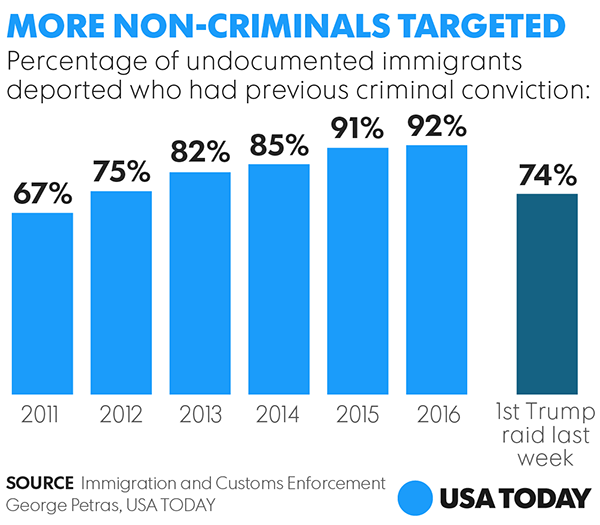Trump immigration raids show greater focus on non-criminals
The first major immigration raid under President Trump shows a clear shift in the federal government’s deportation strategy, focusing more on undocumented immigrants without criminal records than under President Obama.

Of 678 people rounded up in 12 states during raids last week, 74% had been convicted of a crime. That is down from 90% of detained people with criminal records in 2016 under Obama, according to a USA TODAY analysis of more than a dozen federal raids.
For example, during a June 2016 raid conducted in six Midwestern states, 85% of the 324 people arrested had been convicted of crimes. During a raid in those same six states last week, 69% had criminal records.
The increase in arrests of those without criminal records does not appear to be consistent with Trump's promise after his election to use Immigration and Customs Enforcement (ICE) agents to target murderers, rapists and other "bad hombres" who pose serious threats to public safety.
Obama had taken a similar stance by focusing on criminal offenders. After 18 raids in 2016, ICE issued summaries noting that all the undocumented immigrants arrested were "enforcement priorities" who included convicted criminals, gang members, threats to national security, those who recently crossed the border and people with standing deportation orders.
Prep for the polls: See who is running for president and compare where they stand on key issues in our Voter Guide
In summaries of each of the five coordinated raids conducted last week, however, ICE explained it was taking a new course of action. "During targeted enforcement operations, ICE officers frequently encounter additional suspects who may be in the United States in violation of federal immigration laws," the summaries said. "Those persons will be evaluated on a case by case basis and, when appropriate, arrested by ICE."
READ MORE:
Immigrant communities fearful after hundreds arrested in what feds call routine 'surge'
Mexico warns citizens of 'new reality' after undocumented mom deported from Arizona
100 years and 16 presidents ago, a look at another anti-immigration act
David Leopold, a Cleveland immigration attorney and past president of the American Immigration Lawyers Association, said exposing all undocumented immigrants encountered during raids for deportation represents a "major shift" in enforcement that takes the focus away from serious criminals and creates a sense of panic throughout the immigrant community.
"This is the blueprint for mass deportations," he said.
Mark Krikorian, executive director for the Center for Immigration Studies, which favors lower levels of immigration, said the shift is simply common sense. Krikorian, who has advised the Trump administration on immigration policy, said Obama correctly prioritized limited deportation dollars on the most serious criminals. But he said it was a mistake to limit the ability of ICE officers to arrest other undocumented immigrants caught during their operations.
"What's different now is that we've returned to normal enforcement practices where the 'bad hombres' are still job one, but ordinary lawbreakers are no longer exempt from enforcement," Krikorian said.
The ability of ICE agents to arrest undocumented immigrants encountered during their day-to-day jobs is laid out by orders from the president or the secretary of the Department of Homeland Security.
Over the course of his eight years in office, Obama gradually restricted who ICE agents could apprehend. He created the Deferred Action for Childhood Arrivals program in 2012, which granted deportation protections to more than 750,000 undocumented immigrants brought to the U.S. as children. Then, in 2014, Homeland Security Secretary Jeh Johnson issued a memorandum outlining "enforcement priorities" and ordered ICE agents to only capture a limited group of undocumented immigrants.
That led to an increasing percentage of people deported under Obama with a criminal record. In 2011, about 67% of undocumented immigrants deported from the interior of the country had criminal records. The figure rose every year after that, hitting 92% in 2016.
All that changed on Jan. 25, when Trump signed an executive order vastly expanding the pool of undocumented immigrants considered "enforcement priorities." The new list added undocumented immigrants who have been charged with a crime but not convicted, those who have used fake Social Security numbers to find jobs or abused public benefit programs and people who "otherwise pose a risk to public safety or national security."
This week, new Homeland Security Secretary John Kelly reiterated Trump's earlier call to focus on the most dangerous undocumented immigrants. Kelly said ICE agents would have a "specific focus on those who pose a threat to public safety."
John Sandweg, a former acting director of ICE under Obama, said such pronouncements mean little to ICE agents working in the field. Instead, they operate under guidelines set forth by their superiors, in this case Trump's Jan. 25 executive order.
"The priorities are what govern the operations," said Sandweg. "That’s how they’re graded, that’s how their compensation and benefits are awarded, that's how they’re promoted."
